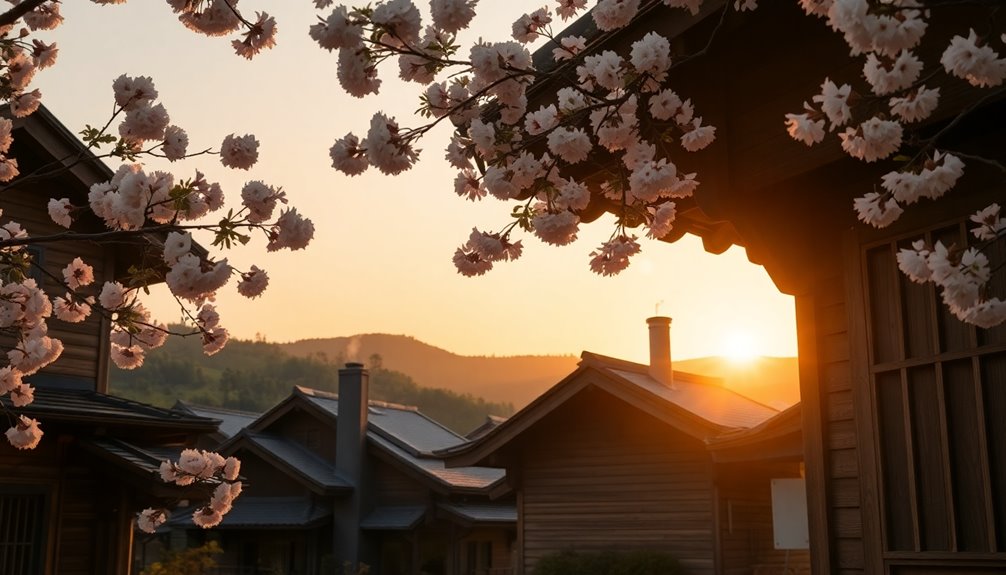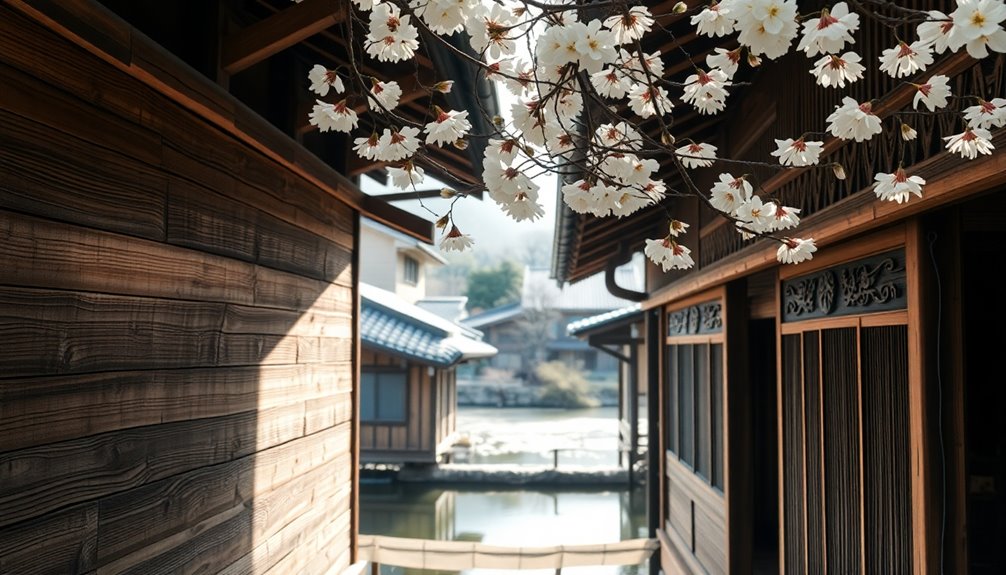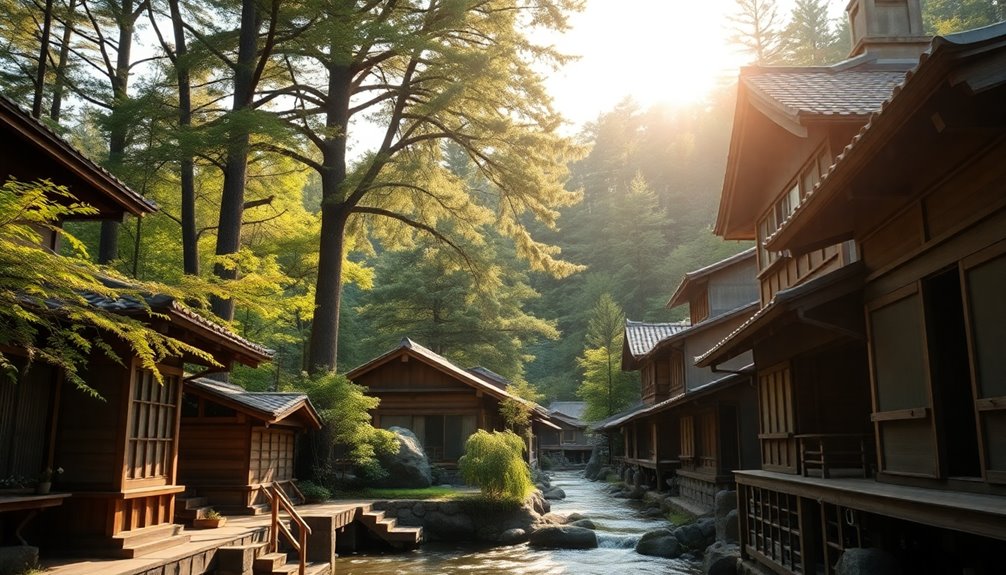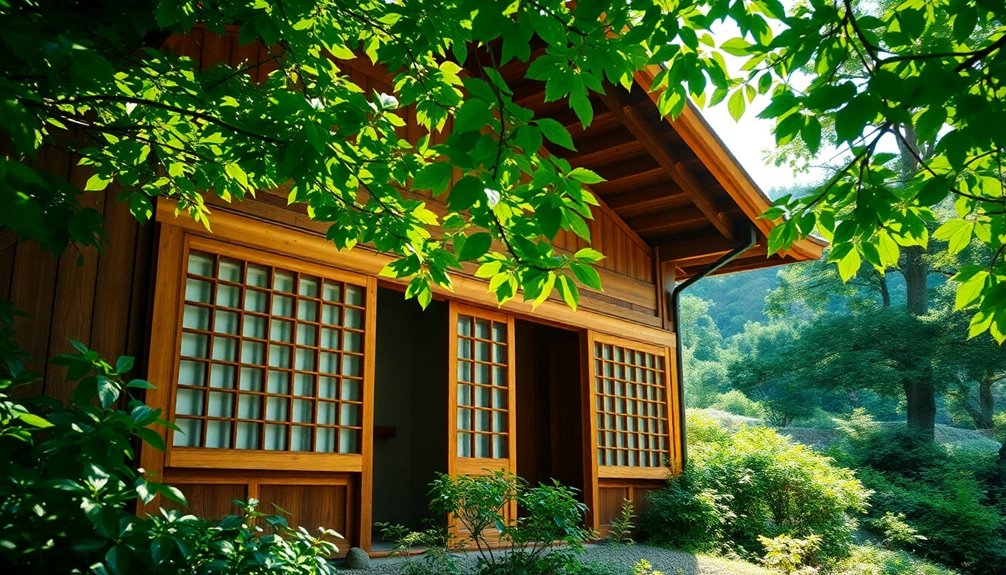In Japan, houses are mainly made of wood for both practical and cultural reasons. Wood offers excellent earthquake resistance due to its lightweight and flexible nature, which helps avoid structural failure. Culturally, wood symbolizes harmony with nature and has been integral to Japanese aesthetics for centuries. It adapts well to the humid climate while providing comfort in cold winter months. Additionally, using timber supports sustainability, as it stores CO2 and comes from renewable resources. This deep connection to nature and craftsmanship shapes Japan's identity in housing. You'll discover even more fascinating insights as you explore further.
Key Takeaways
- Wooden houses in Japan are prevalent due to the abundance of quality lumber from the country's extensive forested land.
- The lightweight and flexible nature of wood enhances earthquake resistance, crucial in Japan's seismic landscape.
- Traditional wooden structures maintain indoor humidity and promote ventilation, adapting well to Japan's climate.
- Wood symbolizes harmony with nature, reflecting Japan's cultural values and aesthetic principles of minimalism and tranquility.
- Sustainable forestry practices ensure that wooden houses contribute to environmental sustainability and carbon sequestration.
Prevalence of Wooden Houses

In Japan, around 80% of single-family homes are made of wood, highlighting the nation's deep-rooted tradition in wooden architecture. This prevalence stems from the abundance of forested land, which covers 66% of the country, providing easy access to high-quality lumber.
Traditional construction techniques, dating back to the Asuka period, showcase a long history of craftsmanship that emphasizes the use of wood. Wooden houses are particularly favored for their lightweight nature and flexibility, crucial in earthquake-prone regions.
The adaptability of these structures allows them to withstand natural disasters better than heavier materials. As you explore Japanese architecture, you'll see how deeply intertwined wooden houses are with the country's cultural and historical narrative, making them an essential part of Japan's identity.
Cultural Significance of Wood

Wood holds a profound cultural significance in Japan, shaping not just architecture but also the nation's identity. For over a millennium, timber has dominated building materials, with structures like Horyu-ji Temple showcasing its durability.
In traditional Japanese homes, wood reflects a deep respect for craftsmanship, evident in advanced joinery techniques that enhance flexibility. This material symbolizes harmony with nature, aligning with Shinto and Buddhist beliefs, essential in temple and shrine designs.
The aesthetic principles promote minimalism and tranquility, emphasizing a connection to nature that fosters balance and simplicity. Additionally, the recognition of artisans as Living National Treasures highlights the value placed on skill and tradition, underscoring wood's integral role in Japan's cultural landscape.
Adaptability to Climate

While Japan's climate presents challenges, the design of traditional wooden houses offers impressive adaptability.
These homes excel in managing the humid climate, absorbing excess moisture during hot summers to maintain an ideal indoor humidity level of around 60%. Features like shoji and fusuma enhance air circulation, regulating temperatures and reducing humidity effectively.
During cold, dry winters, wooden structures release stored moisture, guaranteeing comfort throughout seasonal changes. The lightweight nature of wood allows flexibility in design, enabling homes to withstand harsh weather, including typhoons and heavy rainfall.
Traditional practices like raised floors and open walls promote ventilation, essential for moisture control and preventing mold growth. This thoughtful design guarantees that wooden houses remain comfortable and resilient in Japan's diverse climate.
Earthquake Resistance Benefits

Japan's unique geographical location demands that homes not only adapt to humidity but also withstand the threat of earthquakes.
This is where wooden structures shine regarding earthquake resistance. Wood's lightweight nature means it sways less during seismic events, reducing the risk of structural failure. Unlike heavier materials like brick or steel, wooden homes can absorb and dissipate seismic energy effectively.
The compressive strength of wood—twice that of steel and 9.5 times that of concrete—enhances their durability during tremors. Additionally, traditional Japanese woodworking techniques, passed down through generations, focus on flexibility and resilience, ensuring that these homes remain safe and sturdy.
In Japan, building with wood isn't just a choice; it's a necessity for survival.
Environmental Sustainability of Wood

As the world faces increasing environmental challenges, choosing wooden houses in Japan stands out for their significant sustainability benefits.
Wooden homes utilize renewable timber resources, storing about 14 tons of CO2 and helping combat climate change. By adopting sustainable forestry practices, Japan guarantees a steady supply of high-quality, environmentally friendly building materials while promoting biodiversity.
The lightweight nature of wood construction results in lower CO2 emissions during manufacturing compared to traditional options like brick and steel. In addition, wood's natural properties, such as carbon sequestration and biodegradability, support a circular economy.
Emphasizing local timber not only reinforces sustainable forestry but also strengthens community resilience and economic stability in rural areas, making wooden houses a smart, eco-conscious choice.
Frequently Asked Questions
Why Are Japan Houses Made of Wood?
You might wonder why houses in Japan are mainly made of wood.
It's largely due to the abundance of forests and traditional construction techniques. Wooden structures provide flexibility and resilience, which are essential in a country prone to earthquakes.
They also naturally regulate humidity, making your living environment more comfortable.
Plus, using wood supports sustainable practices, as it's renewable and helps sequester carbon, contributing to a healthier planet.
Why Is Wood Important in Japanese Culture?
Wood's important in Japanese culture because it embodies a deep respect for nature and craftsmanship.
When you see timber in traditional architecture, you're witnessing a symbol of harmony and simplicity. The advanced woodworking techniques reflect the artistry passed down through generations.
Plus, wood connects you to the serene landscapes surrounding you, fostering a calming atmosphere.
It's no wonder that it holds such a revered place in Japan's cultural and spiritual practices.
What Is the Tradition of Wooden Architecture in Japan?
You'll find that the tradition of wooden architecture in Japan is rich and deeply rooted in history.
It showcases a blend of artistry and functionality, with structures designed to harmonize with nature.
You can appreciate advanced joinery techniques that enhance durability while allowing flexibility against earthquakes.
Each wooden building reflects a commitment to craftsmanship, sustainability, and cultural identity, making wooden architecture not just a choice but an essential part of Japan's heritage.
Why Did Japanese Carpenters Choose to Use Wood for Their Buildings?
Japanese carpenters choose wood for their buildings primarily because it's abundant and easily accessible.
You'll notice that traditional techniques emphasize craftsmanship, allowing for structures that are both beautiful and sturdy.
Wood's lightweight nature reduces seismic vibrations during earthquakes, making it safer in those regions.
Plus, its flexibility helps it endure extreme weather.
Conclusion
To sum up, the use of wood in Japanese houses isn't just about practicality; it reflects deep cultural values and environmental considerations. By choosing wood, you embrace a material that adapts beautifully to Japan's climate and stands strong against earthquakes. Isn't it fascinating how a simple choice can intertwine with tradition, safety, and sustainability? As you appreciate these wooden structures, think about how they embody a harmonious relationship between humans and nature, shaping Japan's architectural landscape.









